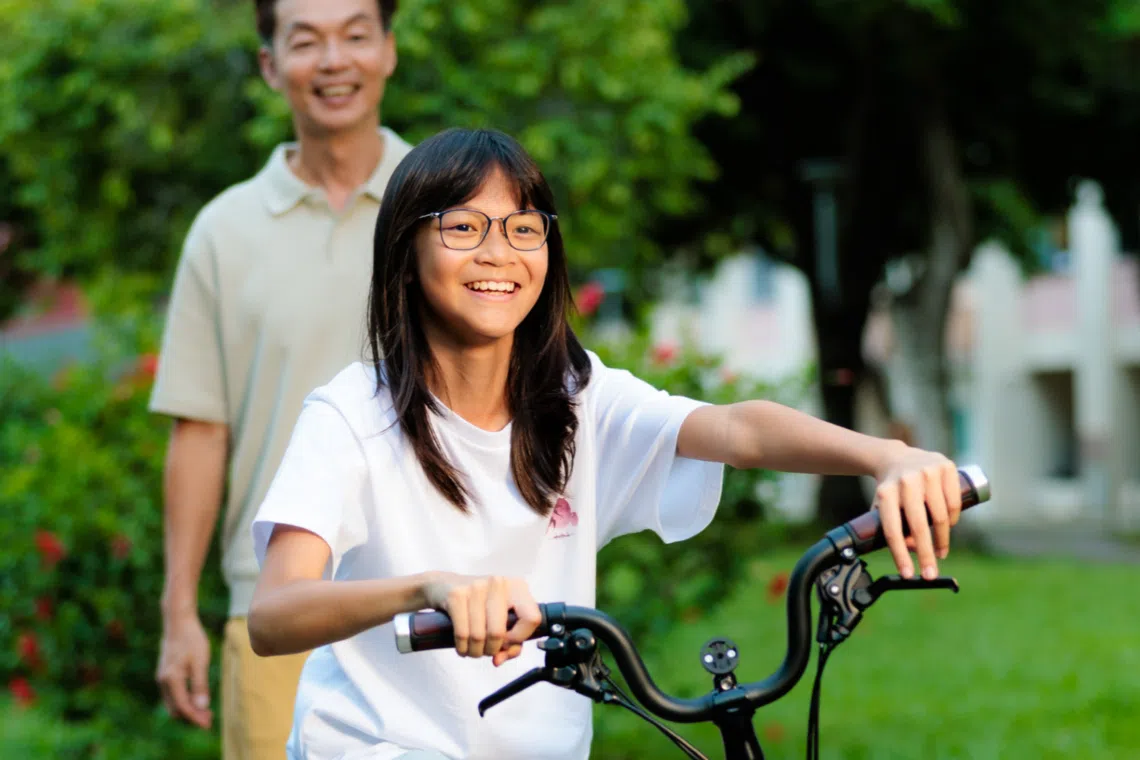Branded content
Outdoor time, eye drops and the right spectacle lenses: How to slow myopia progression in children
Parents can play an active role in protecting their children’s long-term vision by adopting these expert-recommended daily habits

With guidance from an eye care professional, parents can take early steps to manage their child’s myopia and help slow its progression. PHOTO: ESSILOR
Follow topic:
It often starts with a squint – at the whiteboard, a book or TV screen.
For many children in Singapore, this is one of the first signs of myopia, or short-sightedness. About 65 per cent of children are diagnosed with myopia by Primary 6.1 That number climbs to 80 per cent by age 18, and 20 per cent of these individuals may have high myopia.2
High myopia is classified as myopia reaching or exceeding minus 5 dioptres (500 degrees) by the World Health Organisation, while the International Myopia Institute defines it as minus 6 dioptres (600 degrees) or more. This distinction matters because the higher the degree of myopia, the greater the associated health risks.
Dr Kate Gifford, a global expert in myopia management, explains: “Axial length is the length of the eyeball, and we know in children that the eyeball is meant to grow from birth until around age 10 to 12 and then stop. But in myopia, this early development is significant because that eye growth is accelerated or it keeps growing – and these eyes can keep growing throughout childhood and even into the early 20s in some myopes.”
While not everyone with high myopia will encounter complications later in life, high myopia can significantly increase the risk of retinal detachment, glaucoma, cataracts and myopic macular degeneration – conditions that can lead to visual impairment or in severe cases, blindness.3
Even with lower levels of myopia, the risk of such eye conditions is higher compared to those without myopia; while reducing myopia even by 1 dioptre (100 degrees) has the potential to lower the risk of these conditions. The good news is that there are effective ways to manage and slow the progression of myopia. Traditional approaches with single-vision glasses or contact lenses help improve clarity of vision. However, vision correction alone is not enough to control myopia progression.
Myopia can be managed with early intervention, healthier visual habits and new treatment options designed to focus on slowing myopia progression over time.
Working closely with an eye care professional is essential to determine the best treatment approach – or combination of treatments – tailored to each child’s specific needs and circumstances.
Experts call out five important things every parent should know about myopia and controlling myopia progression over time.
Q: Why are so many kids in Singapore getting myopia?
A: Myopia is increasingly prevalent among children in urbanised environments like Singapore. Research shows that excessive near work activities – such as prolonged reading or screen use and little time spent outdoors can significantly raise the risk of developing myopia at a young age.
Genetics and family history also play a part: a child with one myopic parent is three times more likely to develop myopia, and six times more likely if both parents are myopic.
Research found that myopia in children was associated with less frequent outdoor activity. On the other hand, children exposed to strong environmental triggers – who stayed indoors and engaged in a lot of near work – developed myopia even in the absence of a genetic risk.4
Q: What happens if myopia is not addressed early?
A: The earlier the onset of myopia, the more likely it is to progress to high myopia, which is associated with the risk of developing serious eye conditions.5 Beyond health, myopia can also affect education, as clear vision is fundamental to learning. Children struggling with uncorrected myopia may face significant academic challenges, unable to see the whiteboard or read materials clearly from their seats. This visual impairment can severely compromise their educational experience and performance.
Furthermore, myopia may adversely impact mental health. Several studies have indicated elevated levels of anxiety in children and adolescents with myopia6, and myopic children have also exhibited a stronger association with symptoms of depression.7
Eye care professionals stress that the sooner myopia is identified, the earlier it can be addressed and controlled. Limiting the progression of a child’s myopia means minimising possible myopia-related ocular diseases that might develop later in life.
Q: What are the treatment options for high myopia? Are spectacles one of them, and are there other clinically effective solutions?
A: Treatments available include myopia management spectacle lenses, low-dose atropine eye drops and contact lenses – all of which may potentially help to slow myopia progression and reduce the long-term risks associated with high myopia.8
Standard single-vision glasses may help children correct their vision but correction alone is inadequate, which makes it important to look at newer methods that can slow the progression of myopia over time. As the eye continues to grow longer with age, the risk of developing high myopia increases.
Choosing a myopia management lens backed by clinical evidence enables parents to make decisions based on research rather than marketing.
In September, the United States Food and Drug Administration (FDA) authorised the Essilor Stellest spectacle lenses
As the first FDA-approved spectacle lens to slow progression of paediatric myopia, clinical data showed that Essilor Stellest lens slowed down myopia progression in children by 71 per cent on average over two years.10, 11
Managing myopia early with the guidance of an eye care professional helps determine the most suitable treatment approach or combination of treatments for each child’s needs, and can minimise the risks associated with high myopia.

Research shows that spending time outdoors can help lower the risk of myopia in children, especially those with a family history of the condition.
Getty Images
Q: What can parents do to help prevent or manage myopia in children?
A: There is no one-size-fits-all solution for myopia. Early intervention using a range of evidence-based treatments for controlling myopia progression can be employed. These interventions encompass myopia management spectacles, contact lenses and atropine eye drops.
For parents who are concerned about potential side effects from eye drops and the risk of eye infections, myopia management spectacle lenses offer an alternative.
Recent clinical studies have shown that myopia progression control spectacle lenses with Highly Aspherical Lenslet Target (H.A.L.T.) technology saw a reduction in myopia progression by up to 71 per cent. This is compared to traditional single-vision lenses, when worn for more than 12 hours a day for two consecutive years.10, 11 These lenses use advanced technology that creates slowdown signals in front of the retina, which can help slow eye elongation in children with myopia.
These results were maintained up to 19 years of age, highlighting how early intervention can make a meaningful difference in a child’s visual future.
Newer combination therapies are also promising – pairing low-dose atropine drops with H.A.L.T. type of spectacle lenses can enhance treatment effectiveness, helping to slow myopia progression significantly.12
Evidence is also emerging that the effectiveness of spectacle lenses with H.A.L.T. may extend to non-myopic children – especially if they are at high risk of developing myopia.13
Adj A/Prof Au Eong Kah Guan, medical director and senior consultant ophthalmologist at International Eye Cataract Retina Centre in Mount Elizabeth Medical Centre and Farrer Park Medical Centre explains that “current evidence suggests that incorporating the use of low-dose atropine eye drops and myopia control lenses in children who are not yet myopic into current myopia control strategies could potentially be a game-changer in combating the scourge of myopia.”
Eye care professionals will consider your child’s age, lifestyle, progression rate and needs to recommend the most appropriate combination of treatments, ensuring early intervention that can make a meaningful difference in your child’s long-term visual health.
Q: What else can parents do to manage their child’s myopia?
A: Apart from myopia management lenses designed to slow down myopia progression, small daily habits can make a big difference, too.
Encourage your child to spend at least two hours outdoors every day. Natural light has been shown to delay the onset of myopia. Indoors, practising the 20-20-20 rule – taking a 20-second break to look at something 20 feet away every 20 minutes of near work – can help reduce eye strain.
It is also important to limit recreational screen time, pay attention to proper lighting when reading, and ensure screens and books are held at appropriate distances.
Regular comprehensive eye exams – not just simple vision screenings – are key to spotting early changes and tracking progression.
Find out more about how to manage myopia in children at the Essilor website
Footnotes:
1Dirani M, Chan YH, Gazzard G, et al. Prevalence of refractive error in Singaporean Chinese children: the strabismus, amblyopia, and refractive error in young Singaporean Children (STARS) study. Invest Ophthalmol Vis Sci. 2010;51(3):1348-1355. doi:10.1167/iovs.09-3587
2Koh V, Yang A, Saw SM, et al. Differences in prevalence of refractive errors in young Asian males in Singapore between 1996-1997 and 2009-2010. Ophthalmic Epidemiol. 2014;21(4):247-255. doi:10.3109/09286586.2014.928824
3Haarman AEG, Enthoven CA, Tideman JWL, Tedja MS, Verhoeven VJM, Klaver CCW. The Complications of Myopia: A Review and Meta-Analysis. Invest Ophthalmol Vis Sci. 2020;61(4):49. doi:10.1167/iovs.61.4.49
4Philipp, D., Vogel, M., Brandt, M. et al. The relationship between myopia and near work, time outdoors and socioeconomic status in children and adolescents. BMC Public Health 22, 2058 (2022). https://doi.org/10.1186/s12889-022-14377-1
5Hu Y, Ding X, Guo X, Chen Y, Zhang J, He M. Association of Age at Myopia Onset With Risk of High Myopia in Adulthood in a 12-Year Follow-up of a Chinese Cohort. JAMA Ophthalmol. 2020;138(11):1129-1134. doi:10.1001/jamaophthalmol.2020.3451
6Yu S, Yin H, Sun W, et al. The association between myopia and mental health among Chinese children in primary and secondary school: a cross-sectional study. Front Public Health. 2025;13:1598790. Published 2025 Jun 3. doi:10.3389/fpubh.2025.1598790
7Nitzan, I., Shmueli, O. & Safir, M. Association of myopia with anxiety and mood disorders in adolescents. Eye 38, 3016–3018 (2024). https://doi.org/10.1038/s41433-024-03170-6
8Schmidt DC, Hvid-Hansen A, Jacobsen N, et al. Efficacy of interventions for myopia control in children: A systematic review with network meta-analyses. Acta Ophthalmol. Published online April 11, 2025. doi:10.1111/aos.17496
9FDA Authorizes Marketing of First Eyeglass Lenses to Slow Progression of Pediatric Myopia. https://www.fda.gov/news-events/press-announcements/fda-authorizes-marketing-first-eyeglass-lenses-slow-progression-pediatric-myopia
10Compared to single vision lenses. Results from a prospective, randomised, double-masked, multicenter U.S. clinical trial in myopic children aged 6–12 years at initiation of treatment.
11Essilor International, data on file (2025)
12Bao J, Huang Y, Li X, Yang A, Zhou F, Wu J, Wang C, Li Y, Lim EW, Spiegel DP, Drobe B, Chen, H. Spectacle lenses with aspherical lenslets for myopia control vs single-vision spectacle lenses: a randomized clinical trial. JAMA ophthalmology. 2022;140(5):472-8. doi:10.1001/jamaophthalmol.2022.0401
13Lijuan Wang, Yee Ling Wong, Bjorn Drobe, Xiaoqian Wang, Effectiveness of spectacle lenses with highly aspherical lenslets in slowing axial elongation among non-myopic children. Clin Exp Optom. 2025 May 22:1-7. https://pubmed.ncbi.nlm.nih.gov/40401617


